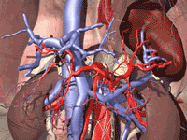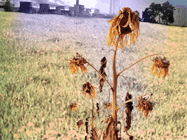|
Carbon tetrachloride (CTC) poses a serious health risk and endangers life on Earth.
Impact at the workplace

CTC is a common cleaning solvent.
Once applied it evaporates quickly into the surrounding air.
In absence of adequate ventilation, workers inhale its
vapors, often over extended periods.
The human body is highly susceptible to the toxicity of CTC.
Occupational exposure affects the central nervous system (CNS), causing headache, weakness,
lethargy, nausea and vomiting. Inhalation of high concentrations may damage the liver and kidneys.
Further an accumulation of fluid in the lung has been observed, possibly as a result of kidney damage.
Exposure to very high levels may result into coma.
Prolonged or repeated exposure can lead to swelling of the liver, destroying or damaging its cells. The severity of the effects on the liver depends on individual susceptibility, route of exposure, diet and co-exposure to other compounds such as alcohol. The solvent is a mild skin irritant and may, over time, cause dermatitis. According to the International Agency for Research on Cancer (IARC), CTC is possibly carcinogenic for humans.
Impacts at global levels

The stratospheric ozone layer protects life on our planet from harmful ultraviolet-B (UV-B) rays. CTC is one of the eight members of the family of ozone depleting substances that destroy it. Its ozone depleting potential (ODP) is 1.1 and is thus more destructive than Chlorofluorocarbons (CFCs). The thinning of the ozone layer, as observed over Antarctica since 1985, led to an increase in the terrestrial exposure to UV-B radiation significantly.
Furthermore, CTC is a green house gas contributing to global warming. It does this by increasing the heat retention capability of our planet's atmosphere. The global warming potential (GWP) of CTC is about 1,400 times higher than that of carbon dioxide, the main greenhouse gas.
Consequences for life on Earth

The occurrence of skin burns, skin cancer and eye cataract increase with exposure to UV-B. Exposure to UV-B also hinders response of the human immune systems. But the ill effects are not limited to humankind alone. The weakening of the immune system has been observed in animals as well. Besides, exposure to UV-B impedes the growth of agricultural crops and other plants and decreases the phytoplankton activities in the upper ocean layer which play a vital role in maintaining the balance of the marine ecosystem. In short, the depletion of the ozone layer causes major disturbances in the eco-system and poses a threat to humankind, fauna and flora alike.
|